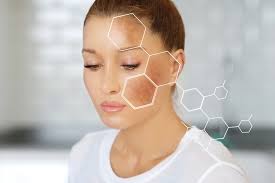
What Is Melasma?
Melasma is a skin condition that causes dark patches or spots to appear, usually on the face. These patches can be gray, brown, or tan in color. Melasma is very common and affects both men and women.
It often appears on the cheeks, upper lip, forehead, or nose.
Sometimes, it also shows up on the neck, chest, and arms—areas that get a lot of sun. It is especially common during pregnancy and is sometimes called the “mask of pregnancy.”
The condition is not dangerous or painful, but it can be frustrating and hard to treat.
What Causes Melasma?
Melasma is caused by too much melanin, the natural pigment that gives your skin its color.Melanin is made by special skin cells called melanocytes. When these cells make too much melanin, it causes dark patches.
Several things can trigger this overproduction of melanin:
Sun exposure
Heat
Hormonal changes (like pregnancy or birth control pills)
Skin inflammation or injury
Certain medications or cosmetics
Genetics or family history
Sunlight is the biggest trigger for melasma because UV rays activate melanocytes. Even heat, such as from a hot shower or sauna, can make it worse.
Hormones also play a major role, especially in women during pregnancy or while using estrogen.
How Is Melasma Diagnosed?
You usually don’t need a biopsy or lab test to diagnose melasma. A doctor can often recognize it by looking at your skin and asking questions.
They may ask if you’re pregnant, using hormonal birth control, or spending lots of time in the sun.
Melasma is most often diagnosed based on:
The location of the dark patches
Your hormone history (pregnancy, estrogen, etc.)
The patch color and pattern
Your history of sun or heat exposure
No signs of skin injury or inflammation in the area
Melasma patches are usually symmetrical—meaning they appear on both sides of your face. They often have a soft-edged, blotchy appearance.
Types of Melasma
Melasma appears in different patterns depending on where it shows up on the skin.
Here are the main types:
Centrofacial Melasma
Most common type.
Affects forehead, nose, cheeks, and upper lip.
Malar Melasma
Found mostly on the cheeks and nose.
Mandibular Melasma
Shows up along the jawline.
Lateral Cheek Pattern
Affects both cheeks on the sides of the face.
Neck Melasma
Appears on the sides or back of the neck.
Brachial Melasma
A rare type that shows up on the shoulders or upper arms.
Melasma Mustache
A “melasma mustache” is when the dark patch forms right above the upper lip. It can look like a faint brown or gray shadow, similar to a mustache.
This is a common form of melasma that many women notice during pregnancy or from sun exposure. Other conditions can also cause darkening above the lip, so diagnosis is important.
These include:
Perioral dermatitis – a red, bumpy rash around the mouth
Lip licking dermatitis – caused by frequent lip licking
Eczema – dry, itchy patches around the mouth
Photosensitivity reactions – caused by perfumes or cosmetics and sun exposure
Melasma and Post-Inflammatory Hyperpigmentation (PIH)
Melasma must be distinguished from other forms of hyperpigmentation like PIH. PIH occurs after an injury, inflammation, or rash leaves a dark mark behind.
PIH can also appear on the upper lip and look like melasma.
Your doctor will look at your skin’s history and pattern of spots to tell the difference.Melasma in Darker Skin Tones
Melasma is more noticeable in darker skin tones due to increased melanin. Dark skin has more pigment cells, so melasma patches may appear darker and more resistant to treatment.
It can also lead to a “halo effect” after treatment. This is when the treated spot lightens faster than the surrounding skin, creating a light ring around the dark patch.
Special care must be taken to avoid over-lightening the skin in people with darker complexions. Gentle products and the right skincare plan are very important for treatment success.
The Role of the Gut in Melasma
Recent studies suggest the gut microbiome might affect skin health, including melasma.The gut helps regulate hormones, including estrogen.
If the gut bacteria are out of balance, estrogen may not be broken down correctly. Some gut bacteria produce an enzyme called β-glucuronidase, which increases estrogen in the body.
This excess estrogen may lead to melasma. People with melasma have been found to have more of certain gut bacteria like Collinsella spp. and Actinomyces spp.
These bacteria are involved in hormone regulation and estrogen reabsorption. Researchers are still studying how gut health affects melasma, but it’s an exciting area of skincare science.
Why Is Melasma So Hard to Treat?
Melasma is difficult to treat for several reasons:
It’s triggered by everyday factors like sun, heat, and hormones. Our face is constantly exposed to light and heat. There is no permanent cure—only ways to manage and fade the patches.
If you stop treatment or stop protecting your skin, melasma can come back. Even with good skincare habits, it can take weeks or months to see improvement.
Consistency is key, and sun protection is the most important step.
Melasma on the Chest
Melasma can show up on the chest, but it’s not very common. More often, dark spots on the chest are caused by:
Phytophotodermatitis – a reaction from plant substances like limes, celery, or figs and sun exposure
Fragrance or cologne – certain scents make skin more sun-sensitive
Cosmetic or chemical reactions
Check the pattern of the spots. If they look like drips or fingerprints, a substance may have caused the reaction. Avoid scented products and apply sunscreen to the chest every day.
Melasma on the Back
Melasma is rare on the back unless you spend a lot of time shirtless in the sun. If you have dark spots and also feel itching on your back, it could be something else.
Notalgia paresthetica (NP) is a nerve-related condition that causes itching in the upper back.The constant scratching or rubbing causes dark patches that may look like melasma.
In this case, treating the itch and healing the skin barrier is more important than using skin-lightening products.Try calming creams, anti-inflammatory ingredients, and antihistamines for relief.
Emotional Effects of Melasma
Melasma doesn’t just affect your skin—it can also affect how you feel.Many people with melasma feel self-conscious or embarrassed about their appearance.
It can lower self-esteem and cause emotional stress. Studies show that melasma is linked to anxiety and depression in some people.
That’s why it’s important to treat not just the skin, but also support confidence and emotional well-being.
Melasma Treatment Tips
There is no cure for melasma, but you can control it with the right skincare routine.
Here are essential steps:
Sun Protection
Wear SPF 30 or higher every day. Reapply often if you’re outdoors.
Avoid Heat
Hot showers, saunas, and warm environments can make melasma worse.
Use Brightening Products
Look for ingredients like niacinamide, azelaic acid, tranexamic acid, and vitamin C.
Try Prescription Creams
A doctor might prescribe hydroquinone, tretinoin, or a triple combination cream.
Chemical Peels or Lasers
These may help but must be used carefully—especially on darker skin types.
Avoid Hormone Triggers
Talk to your doctor if your birth control may be contributing to melasma.
Balance Gut Health
Probiotics and a healthy diet may support skin health from the inside out.
Final Thoughts
Melasma is a common, stubborn skin condition caused by too much pigment production. It can be triggered by sun, heat, and hormones, and is more difficult to treat in people with darker skin.
Although there’s no permanent cure, it can be managed with a combination of lifestyle changes and the right skincare. If you’re dealing with melasma, don’t lose hope.
With patience, consistency, and the right approach, you can fade dark patches and restore confidence in your skin. Let us help you build a skincare routine tailored to your skin type and melasma needs.


